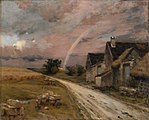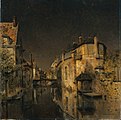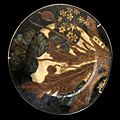Jean-Charles Cazin

Jean-Charles Cazin (geboren 25. Mai 1841 in Samer; gestorben 26. März 1901 in Le Lavandou) war ein französischer Keramiker, Maler, Stecher und Zeichner.
Leben
Jean-Charles Cazin war der Sohn des Arztes François-Joseph Cazin, sein Bruder Henri Cazin wurde ebenfalls Arzt. Er wuchs in Samer und Boulogne-sur-Mer auf. 1862 besuchte er in Paris die Malschule des Horace Lecoq de Boisbaudran und stellte 1863 das Bild Souvenir de dunes à Wissant im Salon des Refusés aus. Ab 1863 bis 1868 arbeitete er als Zeichenlehrer an der École spéciale de dessin d'architecture von Émile Trélat. 1868 heiratete er die Malerin und Bildhauerin Guillet Marie Cazin (1844–1924) und ab 1869 arbeitete er als Kurator im Musée des beaux-arts de Tours und in der Stadt auch als Leiter der Kunstschule. Nach dem Deutsch-Französischen Krieg zogen sie 1872 nach England, um dort mit Alphonse Legros eine Kunstschule zu eröffnen, was aber nicht gelang. Stattdessen dekorierte er in London zahlreiche Keramiken für die Fulham Pottery. Später schuf er zusammen mit seinem Sohn zahlreiche Keramiken.
1874 kehrte er zurück nach Paris und stellte 1876 das Bild Die Werft im Salon de Paris aus. Er ließ sich in Boulogne-sur-Mer nieder und malte historische Genre-Gemälde und biblische Szenen, die auf Unverständnis stießen. Daher konzentrierte er sich auf die Landschaft am Pas de Calais. Im Pariser Panthéon vollendete er Wandgemälde, die Puvis de Chavannes dort begonnen hatte. Für seinen Freund Auguste Rodin stand er im Jahr 1885 Modell für dessen Plastik Die Bürger von Calais, Rodin nahm ihn für die Figur des Eustache de Saint-Pierre. 1893 reiste er mit seinem Sohn, dem Stecher, Medailleur und Keramiker Michel Cazin (1869–1917), mit 180 Bildern in die USA, er wurde dort freundlich empfangen und gewann Henry Clay Frick als Sammler.
Cazin wurde 1882 in die Ehrenlegion aufgenommen und 1889 zum Offizier erhoben. In seinem Geburtsort Samer wurde das „Musée Jean-Charles-Cazin“ eingerichtet mit Bildern, Keramiken und Medaillen Cazins, seiner Frau, seines Sohnes und seiner Schwiegertochter Berthe Cazin (1872–1971).
- Bilder
Die Werft (1875)
Agar und Ismaël (1880)
Regenbogen (1883)
Mitternacht (1891)
Haus in den Dünen
Ansicht in Paris
Mohn
Eichenlaub
Literatur
- G. P. Weisberg: Cazin, Jean-Charles. In: Allgemeines Künstlerlexikon. Die Bildenden Künstler aller Zeiten und Völker (AKL). Band 17, Saur, München u. a. 1997, ISBN 3-598-22757-4, S. 417 f.
Weblinks
| Personendaten | |
|---|---|
| NAME | Cazin, Jean-Charles |
| KURZBESCHREIBUNG | französischer Keramiker, Maler, Stecher und Zeichner |
| GEBURTSDATUM | 25. Mai 1841 |
| GEBURTSORT | Samer |
| STERBEDATUM | 26. März 1901 |
| STERBEORT | Le Lavandou |
Auf dieser Seite verwendete Medien
Autor/Urheber: Rvalette, Lizenz: CC BY-SA 3.0
Plat décoré aux feuilles de chêne de Jean-Charles Cazin au musée des Arts décoratifs de la Faïence et de la Mode au château Borély à Marseille.
Autor/Urheber: Internet Archive Book Images, Lizenz: No restrictions
Identifier: criticismmo00chil (find matches)
Title: Art and criticism : monographs and studies
Year: 1892 (1890s)
Authors: Paul Renouard (1845-1924), Child, Theodore
Subjects: Art criticism
Publisher: Harper
Contributing Library: Whitney Museum of American Art, Frances Mulhall Achilles Library
Digitizing Sponsor: Metropolitan New York Library Council - METRO
View Book Page: Book Viewer
About This Book: Catalog Entry
View All Images: All Images From Book
Click here to view book online to see this illustration in context in a browseable online version of this book.
Text Appearing Before Image:
white-robed angel.Here is Hagar, the despairing mother, whom an angel has suc-cored. It has been a burning hot day; in the sky, rosy, lumpyclouds are rolling across an arid landscape of sand-hills, dottedhere and there with parched and stunted shrubs, and undulat-ing away to a distance bounded by tragic forests. Hagar, nothaving the courage to see Ishmael die, has left him in the bush,and sits desolate on the ground, her empty gourd beside her,clad in a sombre blue robe, and wearing a white coiffe overher head. Meanwhile the angel has appeared and spoken, andHagar raises her head and sees a clear spring where the angelstands, and the white robe of the helpful messenger reflected inthe limpid water. Here is another evening effect: An opalineand roseate sky; in the background a group of farm buildingsand cottages; in the foreground a field, some pollard willows, afelled trunk, on which an old man is seated, his head buried inhis hands, dreaming or sleeping. It is a laborer, who is weary
Text Appearing After Image:
JEAN CHARLES CAZIN. SOME MODERN FRENCH PAINTERS. 53 with wielding the axe all clay. The hour for rest and recom-pense has come, and beside him stands a white figure, beautifuland compassionate, crowned with golden leaves, whom he doesnot see, but who proffers him a crown, with gestures of conge-lation. In M. Cazins mind this old man is Theocritus, and tin-phantom figure is Nature revealing herself to his idyllic soul.Souvenir de Fete is a decorative and allegorical panel, a vi-sion of the French national fete seen from some lofty stand-point. From the windows of his house overlooking the gar-dens of the Luxembourg M. Cazin saw the vast expanse oftree-tops flecked with the glow of Venetian lanterns, the distantdomes of the Pantheon and Val de Grace garlanded with gas-jets, the vast perspective of Paris gay with lavish illuminations,the fireworks bespangling the sombre blue nocturnal firma-ment with the sudden flash of pyrotechnic stars; and on thesouvenir of this reality he embroidered
Note About Images
Autor/Urheber: Rvalette, Lizenz: CC BY-SA 3.0
Plat aux pavots de Jean-Charles Cazin au musée des Arts décoratifs de la Faïence et de la Mode au château Borély à Marseille.
















